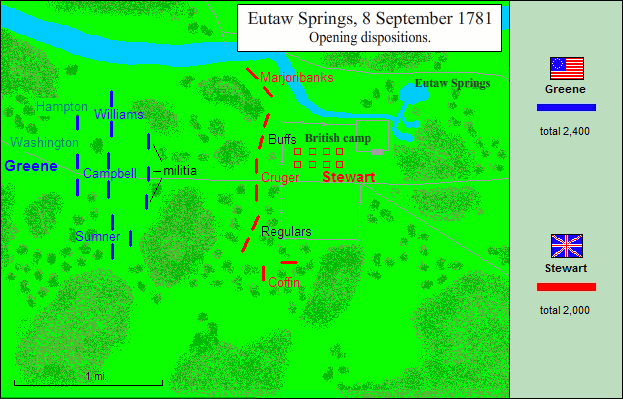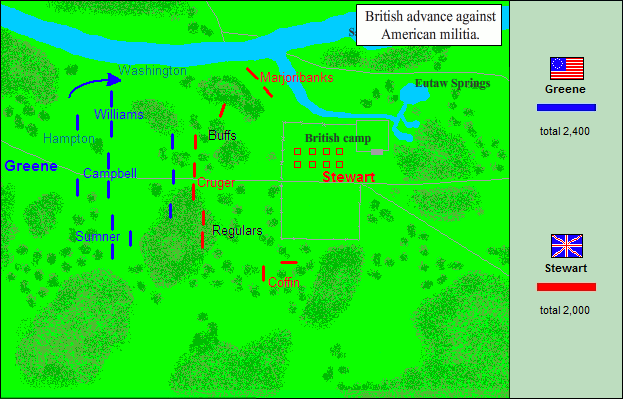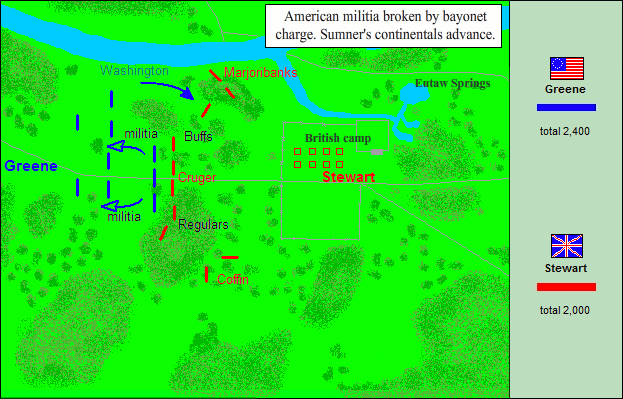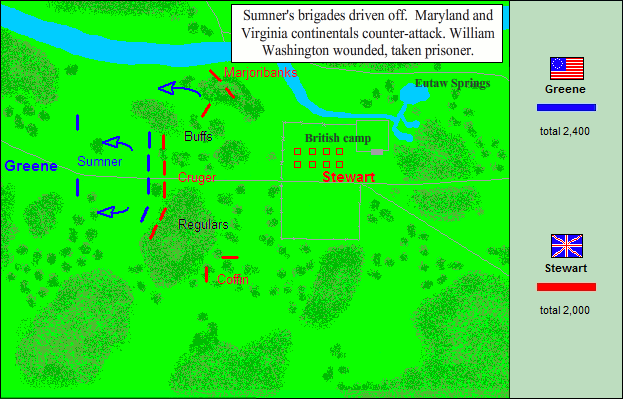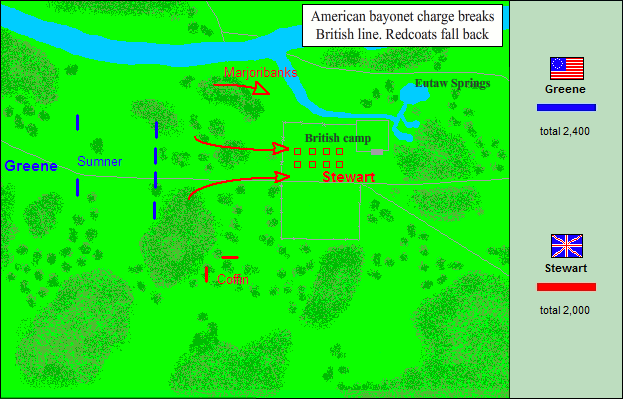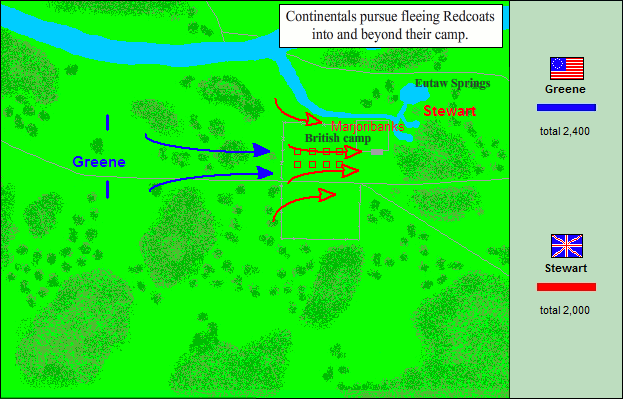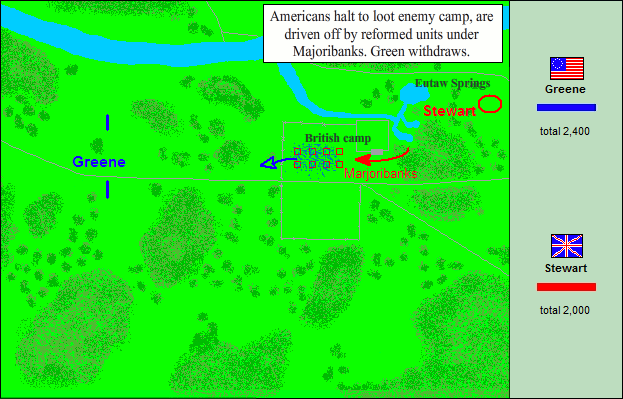General Washington wishes not only from his personal regard to General Greene, but from principles of generosity and justice to see him crowned with those laurels which from his unparalleled exertions he so richly deserves.
–George Washington, in a letter to General Greene
Cornwallis’ frustration in the Carolinas made him think longingly of more promising ground. He admitted in a letter to Clinton in far-off New York that he was “totally in the dark as to [Clinton’s] intended operations in the summer.” He had a good idea as to his own intentions, however. He had conceived a remarkable plan, as remarkable as it was muddled. To Clinton he now proposed that Virginia and “the Chesapeake may become the seat of war, even (if necessary) at the expense of abandoning New York.” For his part he was quite prepared to abandon the Carolinas, leaving small garrisons and the navy to hold the Atlantic posts at Charleston and Savannah. When Clinton and the northern army joined Phillips’ command and his own in Virginia, “a successful battle may give us America.” Regardless of the folly of surrendering the harbor at New York, what Cornwallis did not seem to grasp was that British arms already counted a full measure of successful battles–Long Island, Brandywine, Camden, a dozen others. The war was now in its seventh year, yet none of these victories had given them America. Clinton was frankly appalled at Cornwallis’ proposal, but before he could rein him in, the earl began his march toward the Old Dominion. He imagined that he marched to decisive victory. He was in fact headed for his last post in the trenches of Yorktown.
For his part, Greene did not imagine that Cornwallis would abandon North Carolina. What he feared most was the junction of Cornwallis and Rawdon at Camden, South Carolina, making together a formidable force once more poised to take the war north and undo all he had accomplished that winter and spring. But if Cornwallis meant to go to Virginia, more power to him. Virginia would have to fend for herself for the time being. Greene was willing to take that expedition as an opportunity to retake South Carolina. Even before Cornwallis’ column pushed off, Greene was already in motion south. On 7 April he marched down the Cape Fear River in a feint at Wilmington to the southeast, then turned south to march cross-country toward his true objective, Camden and Lord Rawdon’s garrison. Rawdon certainly represented the greatest threat to Greene’s campaign, but to defeat Rawdon or even to neutralize his force, Greene would have to break up the chain of British posts that made it possible for Rawdon to conduct operations in that sprawling countryside. The most important of these posts ran from Fort Watson on the Santee north of Charleston to Fort Motte upriver at the confluence of the Congaree to Fort Granby just below the confluence of the Saluda and finally to Ninety-Six at its headwaters.
The heavy lifting in the reduction of the British forts would have to fall to the partisans. Lee and Morgan went to work swiftly and surely, galloping out of their swampy stronghold to take Fort Watson on 23 April. At the opposite end of the line upcountry, Pickens surrounded Ninety-Six and laid siege to the fort. It was too strong to take with so small a force, but for the time being the British could move nothing in or out of that country. Two days after Fort Watson fell, Greene closed in on Camden. Believing Rawdons’ works at Camden too strong to be taken, Greene settled in on Hobkirk’s Hill a few miles to the north and invited Rawdon to sally out after him. Rawdon, though just twenty-six, was a battle-tested veteran of long service. He was, moreover, able and ambitious and more than happy to oblige the Rhode Islander. About ten o’clock on 25 April Rawdon pushed ahead with a mixed force of Loyalists and Regulars about 900 in sum. They advanced through the woods on a narrow front two lines deep. The British drove in the Patriot skirmishers without undue difficulty and started up the slopes of Hobkirk’s Hill. Greene had on hand his steady Virginia and Maryland Continentals, but it was not to be their day. Greene, seeing Rawdon’s narrow front, moved to envelop both enemy flanks, but Rawdon simply called up his second line, extended his own flanks, and pushed ahead. When his line of battle struck the 1st Maryland–the same outfit that had helped save the day at Guilford Court House–they fell into unaccountable confusion and withdrew uphill to reform. Doing so of course exposed the flanks of the regiments on either side and before long the whole American line was in brisk retreat. Washington’s first-rate cavalry was supposed to have swept down on Rawdon’s rear as part of the double envelopment but had done little more than scoop up non-combatants in the British camp. Now Washington had to gallop in sweaty haste to cover the army’s retreat. Rawdon pursued but with no particular vigor, and the army fell back bruised but intact a full three miles to the site of Gates’ disaster. Camden, Greene concluded ruefully, “seems to have some evil genius about it[;] whatever is attempted near that place is unfortunate.”
But if Greene’s defeat on Hobkirk’s Hill was unfortunate, Rawdon’s victory did not mean good fortune for his cause really. He held a hill of no special value and was certainly not strong enough to go in pursuit of Greene. He fell back on the sturdy works of Camden to await events. They were not long in coming. Two weeks later Thomas Sumter swept down on Orangeburg on the North Fork of the Edisto River, taking that place on 10 May. And a crippling blow it was, for Orangeburg, just fifty miles south of Rawdon’s garrison, was a crucial link between Charleston and Camden as well as between Charleston and Ninety-Six to the west. The next day Lee and Marion compelled the garrison at Fort Motte on the Congaree to lower their colors after a brief but bitter siege. The Patriots had dug their way close enough to fire the enemy walls and bring the garrison stumbling out in the smoke to surrender. At the end of May, Pickens, having abandoned his efforts against Ninety-Six for the time being, marched south to invest Augusta, receiving its surrender on 5 June. Everywhere British control was collapsing like a house of cards. In fact, Lord Rawdon had already seen enough. On 10 May, he started his sick and wounded down the Wateree toward the Santee and Charleston beyond. He himself followed two days later with the rest of his command. Only Ninety-Six now held out upcountry, and Rawdon sent a rider off to the west with orders to bring that garrison as well. Rawdon was, however, just a step late, for Greene had taken up the offensive where Pickens had left off, laying siege to the place on 22 May. The garrison at Ninety-Six was small, just 500 men under a gristly New York Tory, John Cruger, but it was proving a tough nut to crack. Greene’s men made a determined attack on 18 June with nothing to show for their effort but casualties. Greene might have outcamped the garrison and starved them out, but Rawdon responded swiftly to the emergency. He was on the march now with a force of 2,000, including three fresh regiments just come ashore from England. On 20 June Greene’s men began legging it northward. Rawdon gave chase for a time, but it was unpromising business in punishing heat and he gave it up as a bad job by the time he reached the Enoree River, thirty-five miles off to the northeast. Lord Rawdon’s campaigning days in America were all but over. He had led Marines into that plunging fire on Breed’s Hill back in 1775 when the war was new, and now, at 26, he was worn out in body and soul. He sailed for England in July only to be captured on the high seas. He would be witness to one more conflict, watching the Battle of the Virginia Capes from the deck of a French warship.
Not only were Rawdon’s fighting days over, the war in the American south was all but over. Rawdon was succeeded in command by Lt. Col. Alexander Stewart, but there was not much left to command really, just the tidewater strongholds at Charleston and Savannah to the south. Greene had spent most of the summer camped on the High Hills of the Santee just east of the Wateree, doing his best to refit and reinforce his little army. As the weather cooled a bit in the first part of September, he had Charleston in mind, supposing that one destructive blow against Stewart might bring the harbor back into the republic. Stewart was well within reach, camped at Eutaw Springs on the south bank of the Santee some fifty miles northwest of Charleston. The instrument Greene had to strike with was a good one, about 2,400 of all arms: North Carolina, Virginia, Delaware, and Maryland Continentals, militia from the Carolinas, Lee’s Legion, Marion’s partisans, and Washington’s horsemen. The combatants were fairly evenly matched: Stewart commanded three regiments of Regulars, eight companies of the famous “Irish Buffs,” Loyalist cavalry under John Coffin, and a partisan outfit under tough John Cruger called in from Nintey-Six, about 2,000 fighting men in all.
If Greene had an edge, though, it was in more than mere numbers. Though far from his native Rhode Island, Greene was in essence on his own turf. Loyalist sympathies had been pretty well leached out of the valley of the Santee in the last year. It was possible to maneuver his army within four miles of Stewart’s command without the Briton’s knowledge. Indeed, the first Stewart knew of Greene’s presence in the neighborhood was early on the morning of 8 September when a work detail sent out west of camp to dig yams ran into the screen of Greene’s skirmishers. Behind them was Greene’s entire force. Unfortunate as the encounter was for the yam diggers, it was some luck for Stewart, who had now nearly an hour to prepare for the attack. He shook out a line a hundred yards or so west of his camp, his right flank secured by a small outfit under Major John Marjoribanks in a thick woodlot that bordered on the Santee and his left by Coffin’s cavalry. Cruger’s Tories held the center and the Regulars both wings of the main line. Greene’s attack went forward in two lines, militia in the first and Continentals in the second a hundred yards or so in their rear. The militia pitched in with high spirits and in good order, trading volleys with the British face to face. They did not gain any ground but they held their own well enough until a determined bayonet attack sent them tumbling back. Greene now pushed forward three brigades of North Carolina Continentals under Major General Jethro Sumner. Their disciplined volleys restored the line of the American advance and ratcheted up the pressure on the British once more. Stewart’s men, however, were equal to it and more. Again they surged forward at the point of the bayonet, and the North Carolinians came streaming back.
For Greene it seemed that the hour of opportunity had come. The British line had been pressed hard twice. One more blow with his shock troops and surely they would buckle. Now he committed his Maryland and Delaware veterans to the battle. They struck, broke Stewart’s line, and sent the fragments of it back through their camp and beyond. And precisely here opportunity came and went for the Americans. Once in possession of the British camp, the victorious Continentals could not resist the temptation to stop and relish the spoils of war. There was plenty to eat here and rum to drink, and eat and drink they did, especially drink. While they were plundering the British camp, however, Marjoribanks whistled his men back into action. They had already done good service this day, cutting up Washington’s cavalry and making the commander himself both a casualty and a captive. With the collapse of the main line, they had fallen back behind an imposing brick house just to the right-rear of the camp and hard by Eutaw Springs. When they pitched into the milling celebrants in the camp, there was little resistance. Off the Continentals went on a stumbling run, having snatched defeat from the jaws of victory. Greene ruefully broke off the fighting and called for a retreat. The British reclaimed their looted camp, held the field, and counted another victory and its inevitable casualties.
Stewart’s casualties were not light: 85 killed, 351 wounded, 257 missing in action. Since Greene did not count many prisoners on his retreat, it is very likely that most of Stewart’s missing were simply deserters, men who had had their fill of soldiering and found the American countryside increasingly inviting. (It would be interesting to know how many fine old American families were founded by a British or a German deserter.) Greene’s losses were roughly comparable to Stewart’s: 138 killed, 375 wounded, and 41 missing. Despite his losses, though, Greene had more to show for his defeat than Stewart for his victory. Again, the British had paid in blood for ground that was of no particular value. Soon after the battle, Stewart withdrew from Eutaw Springs, hiking the fifty miles back to Charleston. The end of the war in the south came as quietly as that: a column of dispirited soldiers trudging down the sandy South Carolina roads headed for the coast. Or rather the imperial war was at an end, for civil war between Whig and Tory would flare up here and there for another year. The British held just Charleston and Savannah now, and their garrisons had nothing to look for but the sail that would take them home.
It would be difficult to exaggerate the extent of Nathanael Greene’s achievement in the south or his contribution to America’s ultimate victory. In the winter of 1780 this Yankee who had never been south of the Potomac took command of the Southern Department. He sorted out the demoralized fragments of Gates’ Camden disaster and recast them into an able and effective army. With the aid of invaluable subordinates like Dan Morgan and Otho Williams, he put his army in the field and took on Cornwallis and the best the British had to offer. He did not win many battles, but he proved throughout to be imaginative, indefatigable, and in the end indomitable. Simply to stay in the field and compel the British to sweat and bleed was enough. As Greene wrote, “we fight, get beat, rise and fight again.” Simply staying the course was likewise enough to encourage Patriot militias and partisans to turn out and hold fast and ultimately to win the hearts and minds of the common folk throughout the south. General Washington put Greene’s achievement most gracefully. As he wrote to Greene in 1781: “General Washington wishes not only from his personal regard to General Greene but from principles of generosity and justice to see him crowned with those laurels which from his unparalleled exertions he so richly deserves.” While Greene’s men camped in an arc outside of Charleston, the American war of independence was already moving toward its climax in Virginia.

